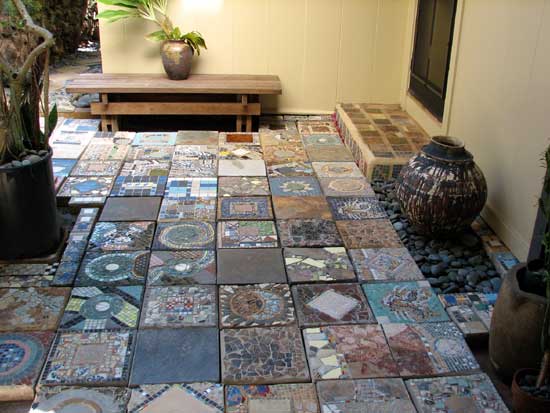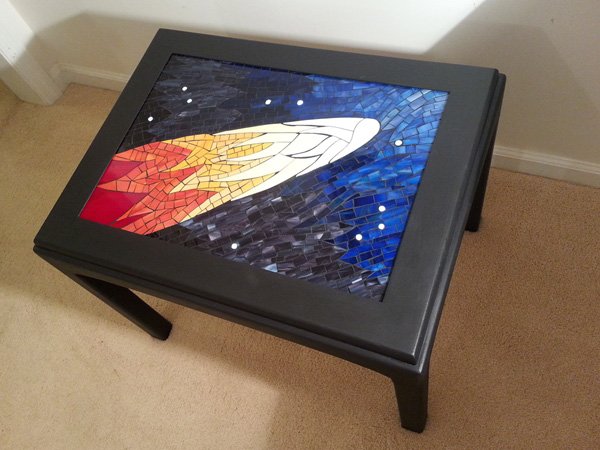
How Mosaic Artwork Is Displayed
The mosaics featured on this page are inspiring examples of mosaic artwork that was integrated into architectural spaces and interior design. We also offer some ideas and guidance about displaying your own mosaic artwork.
In the mosaic patio above by Victor Kobayashi, individual mosaic stepping stones were arranged in a “quiltwork” of different designs. This modular use of stepping stones to create a rearrangeble floor is a great concept, and not just in the finished product.
The stepping stones are made one at a time, allowing the artist to spread the work over time where it can be enjoyed. By avoiding a large construction project with workers, equipment, dust and disruption, the artist is able to sit in their own patio and literally build the space around them in their own time.
The crazy-quilt design also allows the artist to pursue different design ideas instead of being exhausted by a one large design where creativity and enthusiasm are potentially gone before the work is done.
Note that the mosaic stepping stones above were made by using thinset bonding mortar to attach tiles to pre-made concrete stepping stones. Stepping stones are also made by pressing tiles into wet cement in stepping stone molds.
In addition to stepping stones, contemporary mosaic art is typically encountered in a funtional form such as flooring or a mosaic backsplash or mosaic tabletop or as a frame for picture or mirror. However, it is possible to make a small mosaic picture or abstract design and display it simply as an object of art
Small Mosaic Pictures
Small mosaic pictures can be easily displayed in several ways.
A popular method is to make a small framed base by glueing 1/4″ or 3/8″ plywood into a small wooden picture frame.
Still more popular is the small desktop easel, such as typically used to display china plates.
Pieces of flat flagstones are often used as the base for these desktop mosaics displayed in easels. The flagstone works particularly well for creating authentic-looking reproductions of fragments of Roman Mosaic, and the unfinished edges and irregular shapes seem to look good with contemporary designs too.

Sanded pieces of plywood (birch or maple or oak) are good bases for desktop mosaics because they minimize weight and the risk of scratching of surfaces. However, it is best to glue a piece of felt to the bottom of any mosaic, even the plywood-based mosaics, if you intend to display them horizontally on a desk or table as a paperweight or trivet. We sell maple and birch mosaic backer boards in different sizes which can be used in this fashion.
Displaying mosaics upright in an easel gives better visibility. The price and quality of the easels available varies significantly, ranging from cheap transparent plastic ones designed to be as small and unobtrusive as possible to to very fine wood and metal easels that lift the artwork a few inches off the surface.
Larger wrought-iron display easels are available for floor-level use on patios. Note: it is important to anchor larger mosaic plaques in the back to prevent a toddler from pulling it over, and select a location where it isn’t a hazard for foot traffic.
All varieties of display easels can be easily found and purchased online. Email us if you have suppliers you wish to recommended suppliers or tales about certain products.
Some Advice Concerning Wooden Mosaic Tables
Wooden tables should only be used indoors. Humidity warps wood over time making tiles pop off. Plywood is sometimes used as a mosaic backer inserted into a metal base. In this case, the life of the mosaic can be extended by sealing the mosaic with tile and grout sealer and painting the edges and bottom surface with outdoor paint.

Most used coffee tables are made from thin laminates and aren’t real wood. They can be difficult to sand down (for the mosaic adhesive to stick),and they are usually loose in their joints due to use. However, some old used coffee tables are solid wood and can be used. Also, some tables have a rim where it is possible to insert a thin piece of plywood to serve as the actual base of the mosaic.
The best sources of solid wooden tables for mosaic are unfinished furniture stores and websites.
The MAS studio has used hardwood molding from the building material store to make borders around mosaics installed on wooden tables.
Some Safety Advice Concerning Metal Mosaic Tables
- Never make tables unstable by overloading the tabletop.
- Small bistro tables can fall over with dangerous force.
- Place small/tall tables in corners to minimize the risk of overturning them.
- Not all old metal patio tables make a good base.
- Have a local welder inspect and reinforce tables if you have any doubts.
- Old wrought iron patio tables of a certain age are usually heavy enough to function as a base.
- More recent iron and aluminum patio tables often don’t appear to be heavy enough or sturdy enough.
- Never overload tabletops with mosaic.
- The center should be supported as well as the edges.
- Plywood tabletops left outdoors will eventually warp and disintegrate due to humidity.
- Plywood tabletops can be made to last much longer by sealing the mosaic painting the edges and bottom surface with outdoor paint.
- Concrete backer board needs to be fully supported by the base.
- The MAS studio has used 1/4 inch concrete backer board glued to 3/8 inch plywood as a tabletop base.
- Ideally, the rim of the metal table should extend above the height of your mosaic.
- Consider having a local welder friend fabricate what you need. Or fabricate a new table.
- Remember, most old tables aren’t worthy of the work you will put into the mosaic.
Some Safety Advice Concerning Hanging Mosaics on Walls
- Mosaics can be quite heavy and you should never create a safety problem by suspending a large mosaic by a small nail or picture hanger as you might do for a painting of the same size.
- Larger mosaics including larger mirror/picture frames that have been covered in mosaic should be securely anchored to the wall.
- Make sure that your nails or screws go through the structural frame or backer of the mosaic and into the studs inside the wall and not just drywall. Use multiple screws or nails.
- Do not overload walls. Consult a local carpenter if you have any doubts.
- Keep in mind that mosaic was used historically as an architectural element, meaning it was built into floors and walls. If you want something portable, you need to keep the size relatively small.